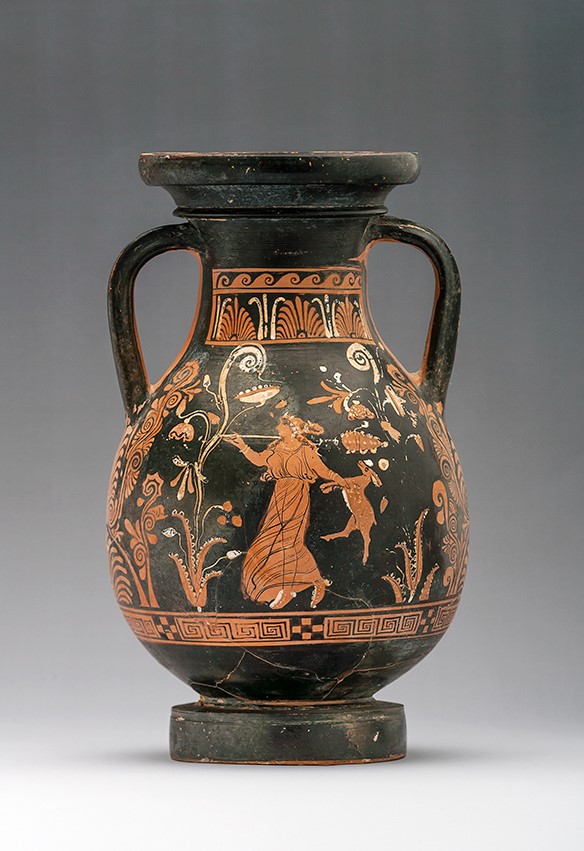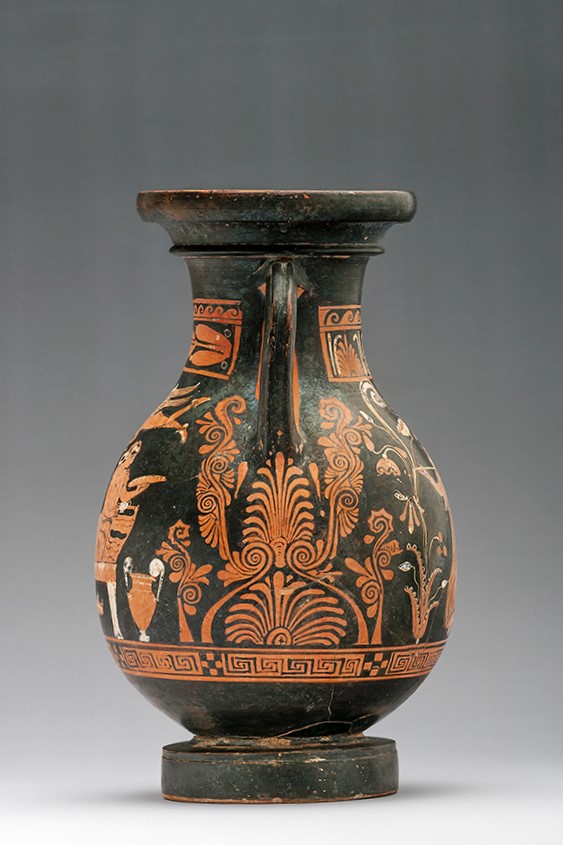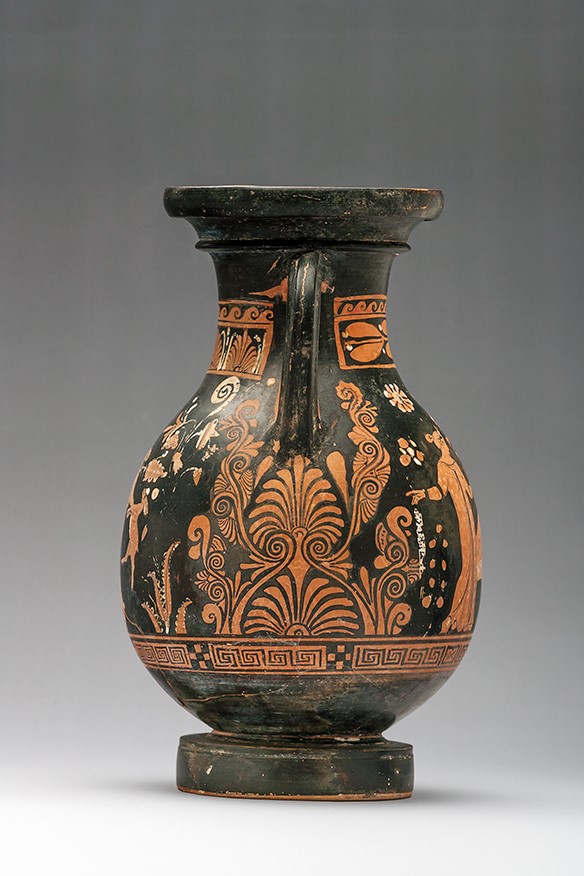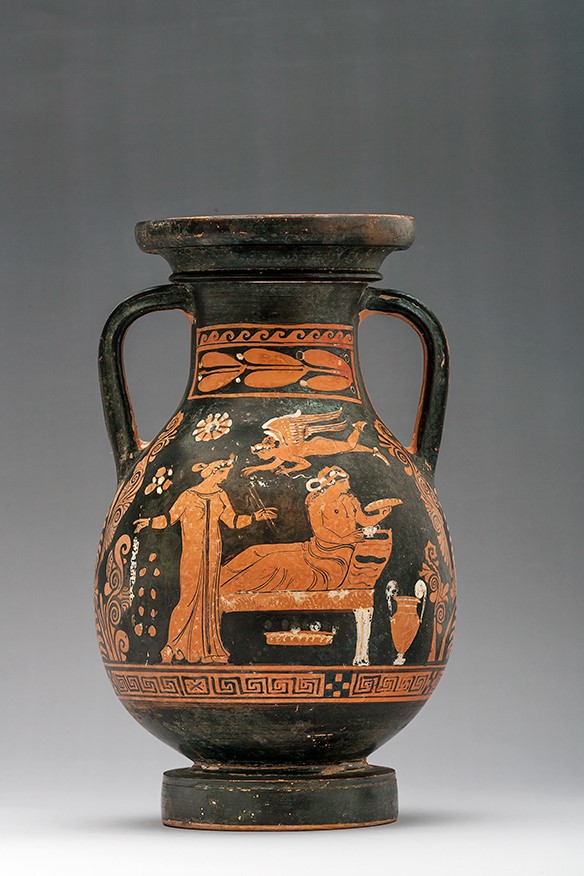Acquisition number: 1976.13
Apulian Red-Figure Pelike.
Reconstructed from fragments but without repainting. Brown-buff clay, reddened on the reserved outer surfaces. Squared handles. Lustrous, somewhat metallic black glaze.
A: Dionysos with kantharos and phiale reclining on a couch; to the left is a female with pipes in her left hand and a fillet in her right; above flies an Eros carrying a wool fillet. A volute-krater stands on the ground to the right; in front of the couch is a table with sashes and eggs; by the female is a plant growing from the ground. There is liberal use of added white, much of it with yellow over; note its use for the woman's diadem, the decoration of her kekryphalos, her earring, necklace, the crosses that decorate her dress, and her shoes. Dionysos wears a garland wound with a wool fillet about his head, and, from it, tie-strings (now faded) hang down onto his shoulders. The edge of the couch has white dots. There is much relief line with relief contour for the body, arms and legs of the Eros. Above the scene is a band of olive with yellow dot-fruit and a band of wave pattern.
B: Maenad moving left with a thyrsos over her right shoulder and a kid in her left hand. There is liberal use of added white and yellow, especially for the floral work to either side of the figure. Above is a band of lotus and palmette, the lotus yellow, and a band of wave pattern.
Below the handles are elaborate palmette designs. The underside is reserved. There is a glaze wash inside the vase.
Title: Apulian Red-Figure Pelike - 1976.13
Acquisition number: 1976.13
Attribution: Chini Floral Group in the Circle of the Lycurgus Painter.
Author or editor: J.R. Green
Culture or period: Apulian Red-Figure.
Date: c. 340 BC.
Material: Clay - Terracotta
Object type: Pottery - Red-figure
Dimensions: 168mm (w) × 282mm (h)
Origin region or location: Italy
Origin city: Apulia.
Display case or on loan: 8
Keywords: Apulian, Red Figure, Dionysos, Eros, Maenad, Chini Floral Group, Lycurgus Painter
A.D. Trendall, Greek Vases in University House (Canberra 1960) fig. 6a-b;A.D. Trendall and A. Cambitoglou, The Red-Figured Vases of Apulia, i (Oxford 1978), 130 no. 16/79; J.R. Green with B. Rawson, Catalogue of Antiquities in the Australian National University, A.N.U. (Canberra, 1981) 47-8.
1976.13
Apulian Red-Figure Pelike
Lent by University House. Ht 28.2cm; diam. 16.8cm.
Reconstructed from fragments but without repainting. Brown-buff clay, reddened on the reserved outer surfaces. Squared handles. Lustrous, somewhat metallic black glaze.
A: Dionysos with kantharos and phiale reclining on a couch; to the left is a female with pipes in her left hand and a fillet in her right; above flies an Eros carrying a wool fillet. A volute-krater stands on the ground to the right; in front of the couch is a table with sashes and eggs; by the female is a plant growing from the ground. There is liberal use of added white, much of it with yellow over; note its use for the woman's diadem, the decoration of her kekryphalos, her earring, necklace, the crosses that decorate her dress, and her shoes. Dionysos wears a garland wound with a wool fillet about his head, and, from it, tie-strings (now faded) hang down onto his shoulders. The edge of the couch has white dots. There is much relief line with relief contour for the body, arms and legs of the Eros. Above the scene is a band of olive with yellow dot-fruit and a band of wave pattern.
B: Maenad moving left with a thyrsos over her right shoulder and a kid in her left hand. There is liberal use of added white and yellow, especially for the floral work to either side of the figure. Above is a band of lotus and palmette, the lotus yellow, and a band of wave pattern.
Below the handles are elaborate palmette designs. The underside is reserved. There is a glaze wash inside the vase.
The youth on the couch can reasonably be taken as Dionysos, a possibility perhaps reinforced by the presence of the maenad on the other side. The combination of Dionysos and Eros was by now a commonplace in South Italian pottery and society more generally: see for example C. Isler Kerényi, “Dioniso ed Eros nella ceramica apula”, in: G. Sena Chiesa and E.A. Arslan (eds), Miti greci. Archeologia e pittura dalla Magna Grecia al collezionismo (Milan 2004) 244-250, or the very instructive krater decorated by Asteas: E. Simon, “Ein neuer signierter Kelchkrater des Asteas”, Numismatica ed Antichità Classica. Quaderni Ticinesi 31, 2002, 115-127, and again in her article in C. Marconi (ed.), Greek Vases: Images, Contexts and Controversies. Proceedings of the Conference sponsored by The Center for the Ancient Mediterranean at Columbia University, 23-24 March 2002 (Columbia Studies in the Classsical Tradition, 25, Leiden 2004) 113-122. On it, Dionysos and Aphrodite accompanied by Eros meet and exchange gifts.
On floral-work in South Italian vase-painting, see inter alios K. Schauenburg, “Zur Symbolik unteritalischen Rankenmotive”, Mitteilungen des Deutschen Archäologischen Instituts, Römische Abteilung 65, 1957, 198-221; H. Jucker, Das Bildnis im Blätterkelch (Olten 1961).
Attributed to the Chini Floral Group in the Circle of the Lycurgus Painter. The Lycurgus Painter, who took up the tradition of the Iliupersis Painter of the previous generation, was a major figure in the development of the ornate manner in Apulian red-figure in the years around the middle of the fourth century (see RVAp i chapter 16). We may see his influence here in the elaborate treatment of the maenad's drapery and the colourful floral work. For characterisations of the Lycurgus Painter, see (in addition to RVAp) the articles by A. Oliver Jnr., “The Lycurgus Painter: an Apulian Artist of the Fourth Century B.C.”, Bulletin of the Metropolitan Museum of Art, New York 21, 1962, 25-30, and G. Sena Chiesa, “Vasi apuli di stile ornato del Pittore di Licurgo ed a lui prossimi”, Acme (Milan) 21:3, 1968, 3-55, and “Un pittore di miti: il Pittore di Licurgo”, in: Sena Chiesa and Arslan (eds), Miti greci (Milan 2004) 226-235, the latter with good illustrations, and now M. Denoyelle and M. Iozzo, La céramique grecque d’Italie méridionale et de Sicile (Paris 2009) 141-143. Our pelike is by a relatively late follower and should be dated towards 340 BC.
A.D. Trendall, Greek Vases in University House (Canberra 1960) fig. 6a-b;A.D. Trendall and A. Cambitoglou, The Red-Figured Vases of Apulia, i (Oxford 1978), 130 no. 16/79; J.R. Green with B. Rawson, Catalogue of Antiquities in the Australian National University, A.N.U. (Canberra, 1981) 47-8.
University House, Australian National University.
1 Balmain Cres, Acton ACT 2601.
(02) 6125 5211.



